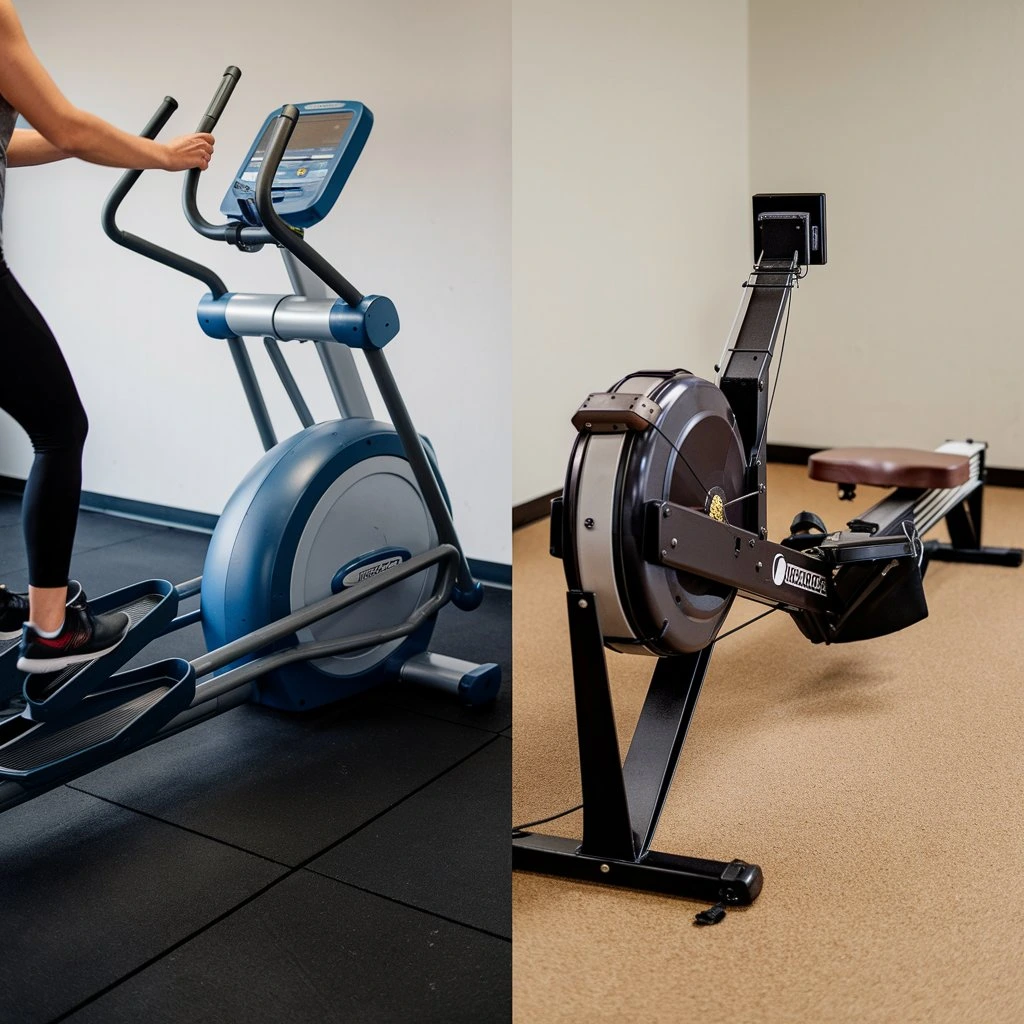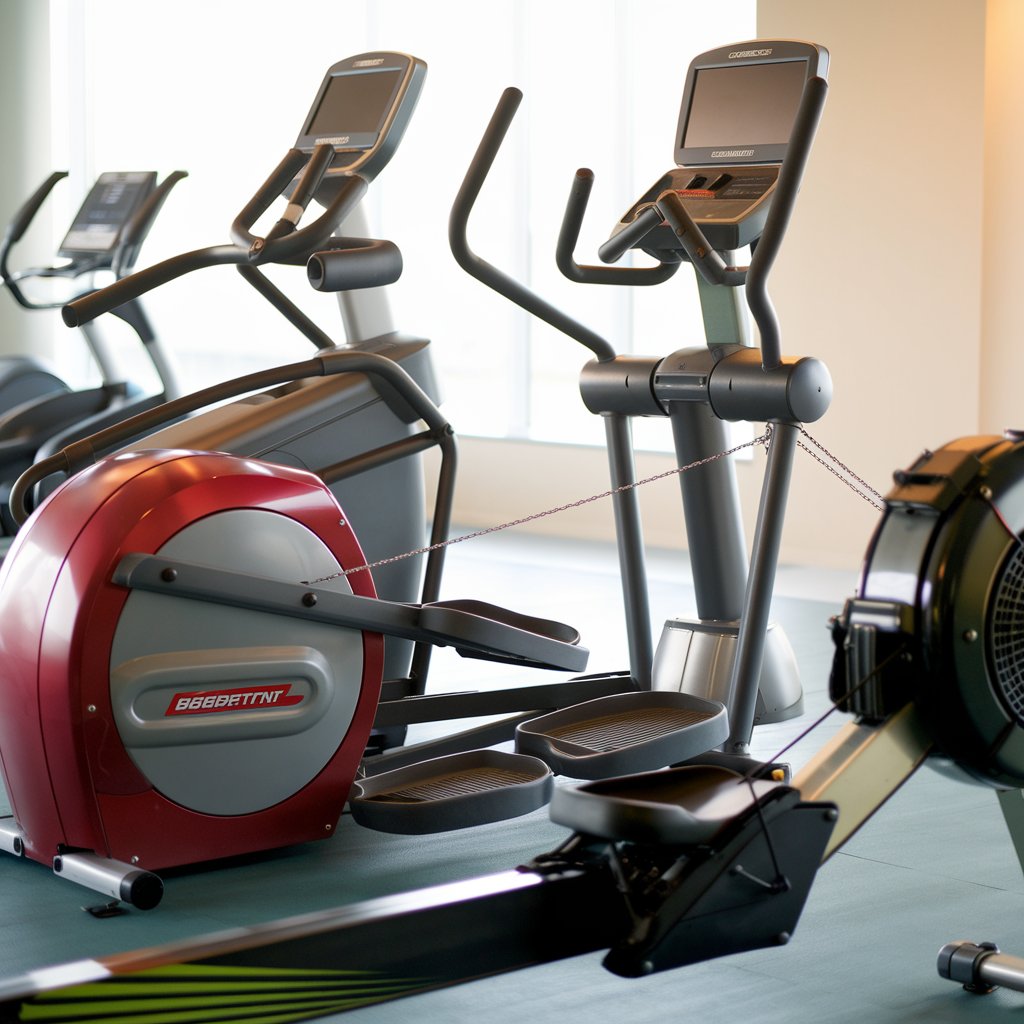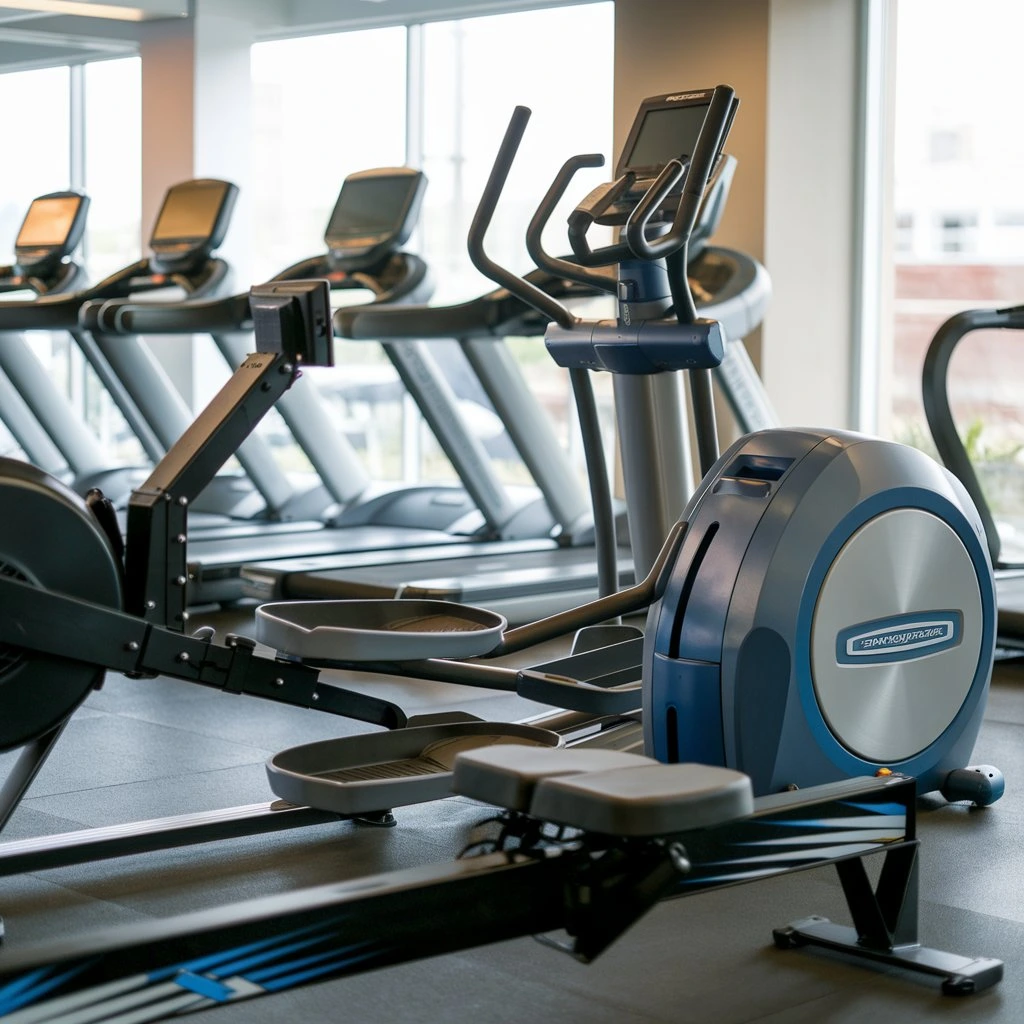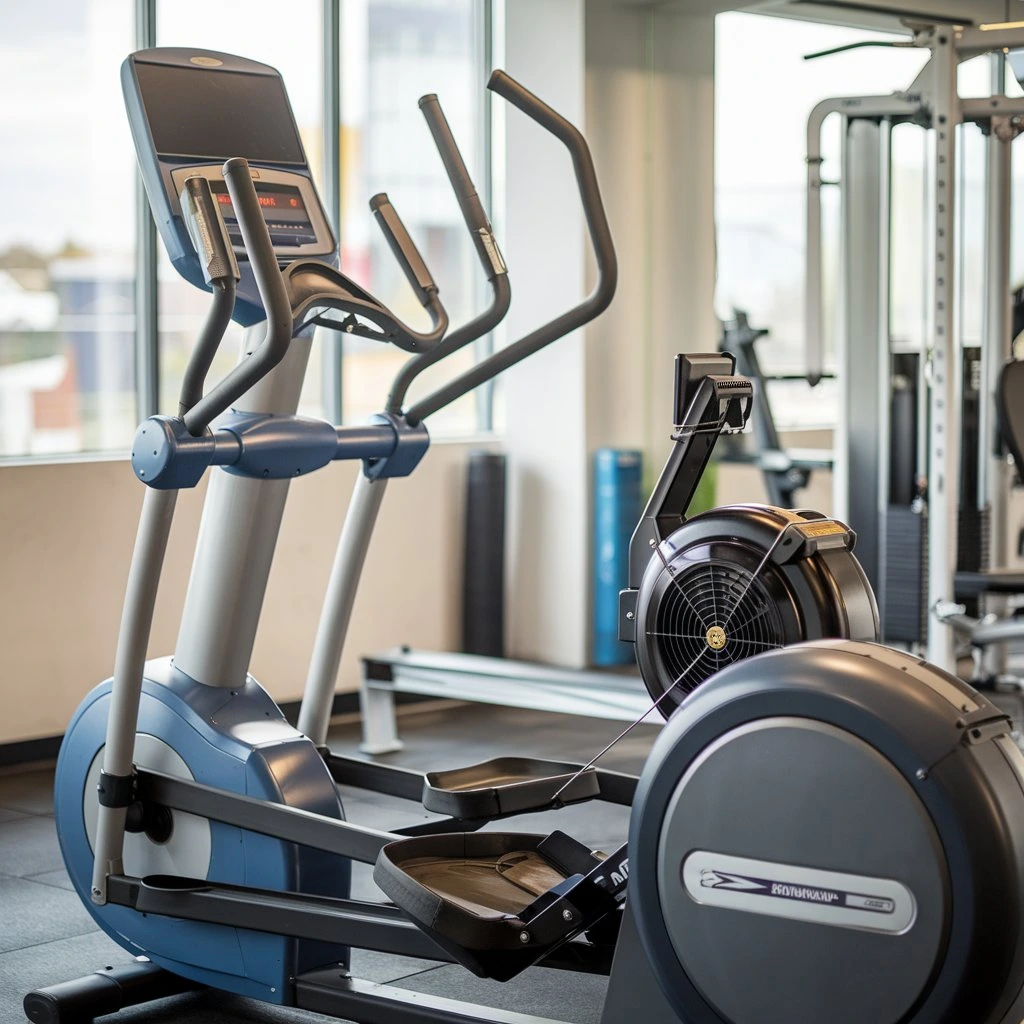Cardiovascular Workout
Both the elliptical trainer and the rowing machine offer effective cardio workouts. But, they differ in impact, muscle use, and intensity. Here’s a comparison:
- Impact on Joints:
- The elliptical trainer provides a low-impact workout. It is good for people with joint issues. It also suits those who want to cut stress on their joints.
- Rowing is generally low-impact, but it does involve some impact. This happens as your feet push the footrests. But, it is still gentler on the joints compared to high-impact activities like running.
- Muscle Engagement:
- The elliptical trainer works both upper and lower body muscles. It works the legs, glutes, arms, and shoulders. But, you can adjust the emphasis based on the machine’s settings.
- A rowing machine provides a full-body workout. It engages major muscle groups, such as the legs, arms, back, and core. Rowing involves a leg push and an arm pull. It also uses the core for stability.
- Intensity:
- The Elliptical Trainer offers a moderate-intensity workout. You can adjust it by changing the resistance level and incline. It’s suitable for beginners to advanced exercisers.
- Rowing Machine: Provides a higher intensity workout compared to the elliptical trainer. Rowing takes more effort. It uses more energy because it involves many large muscles. It can be particularly effective for building strength and improving cardiovascular fitness.
- Variety and Challenge:
- Many elliptical machines offer workout programs and resistance levels. These keep workouts hard and prevent boredom.
- Rowing Machine: Rowing machines also offer various resistance settings and workout programs. Additionally, you can vary rowing workouts by adjusting stroke rate, duration, and intensity.
- Skill Level:
- The Elliptical Trainer is easy to use. It’s suitable for people of all fitness levels, including beginners.
- Rowing Machine: You can learn rowing techniques. But, it may take practice to master proper form. But, rowing machines are still accessible to users of various skill levels.
Muscle Engagement
Elliptical Trainer:
- targets lower body muscles such as quadriceps, hamstrings, glutes, and calves. The elliptical machine targets the quadriceps, hamstrings, glutes, and calves, as you mentioned.
- The elliptical motion is a continuous, fluid movement. It mimics walking, jogging, or climbing stairs, depending on the settings.
- The quadriceps (front thigh muscles) engage when you push down on the pedals. The hamstrings (back thigh muscles), glutes (buttocks), and calves work. They do this when you extend your legs behind you.
- Some elliptical machines have moving handlebars. They engage the upper body muscles. These include the chest, back, shoulders, and arms. But, they engage them to a lesser extent.
- Rowing Machine:
- Rowing works the upper body muscles. But, it also uses the lower body muscles a lot.
- Rowing works the quadriceps, hamstrings, glutes, and calves. They push off the footrests, extend the legs, and power the stroke.
- Leg drive is key in rowing. You push against the footrests using your legs to start the stroke.
- Also, rowing works the back, shoulders, and arms. They pull the handle towards the body during the stroke.
Comparison
- Both machines engage similar lower body muscles. These include the quadriceps, hamstrings, glutes, and calves.
- The intensity of muscle engagement may vary. It depends on factors such as resistance, speed, and exercise duration.
- Elliptical machines provide a low-impact workout. This may be better for people with joint issues or injuries.
- Rowing machines offer a full-body workout, engaging both upper and lower body muscles.
- Some models have movable handlebars. They work the upper body muscles, including the chest, back, and arms.
- Provides a low-impact cardiovascular workout.
- Offers options for adjusting resistance and incline to vary intensity.
Rowing Machine
- Engages a wide range of muscles including legs, arms, back, shoulders, and core.
- Utilizes a pulling motion that activates muscles in both the upper and lower body.
- Provides a high-intensity cardiovascular workout.
- Emphasizes proper technique to avoid strain and maximize effectiveness.
- Adjust it to vary intensity levels by changing the resistance.
- Particularly effective for improving cardiovascular fitness, strength, and endurance.

Impact and Injury Risk
- Elliptical Trainer:
- Low-Impact: Elliptical trainers offer a low-impact workout due to their fluid motion. This makes them good for people with joint issues. They are also good for those recovering from injuries.
- The elliptical motion reduces stress on joints. It helps knees and ankles. This makes it a good choice for people with joint pain or conditions like arthritis.
- Rowing Machine:
- Rowing is generally low-impact. It doesn’t stress the joints much.
- But, using bad technique or overuse can strain the lower back and knees. It’s essential to maintain proper form to cut the risk of injury.
- Rowing also works the core muscles. It requires proper posture the whole time. Poor form or overexertion can lead to discomfort or injury in the lower back.
Calorie Burn and Intensity
Both the Elliptical vs Rowing trainer and the rowing machine offer effective cardiovascular workouts. But, they differ in intensity, muscle use, and benefits.
- Intensity:
- Elliptical Trainer: Provides a moderate-intensity workout. It’s good for people of various fitness levels, including beginners. Users can adjust resistance levels to increase intensity.
- Rowing Machine: Offers a higher-intensity workout. Rowing engages many muscle groups, resulting in a more demanding cardiovascular workout. It can lead to greater calorie burn in a shorter amount of time compared to the elliptical trainer.
- Muscle Engagement:
- The elliptical trainer targets the lower body muscles. This includes the quadriceps, hamstrings, glutes, and calves. Some models may also incorporate moving handlebars to engage the upper body muscles.
- Rowing Machine: Engages both upper and lower body muscles. Rowing works the legs, core, back, shoulders, and arms. It gives a full-body workout.
- Joint Impact:
- The Elliptical Trainer offers a low-impact workout. It is suitable for those with joint issues or recovering from injuries. The smooth, gliding motion reduces stress on the knees, hips, and lower back.
- Rowing Machine: Rowing is low-impact. But, it does stress the joints. This is especially true for the knees and lower back. This is if you do not keep proper form. But, compared to activities like running, rowing is gentler on the joints.
- Workout Variety:
- An elliptical trainer provides many workout programs and resistance levels. They keep workouts hard and prevent plateaus. Users can also pedal backward to target different muscle groups.
- The rowing machine offers many kinds of workouts. These include steady rowing, intervals, and race simulations. Rowing machines often have pre-set workouts. Users can also adjust the resistance levels to fit their training.
- Calorie Burn:
- The elliptical trainer provides effective calorie burn. This is especially true when you use high resistance levels and interval training. The calorie burn varies based on factors. These include intensity, duration, and fitness level.
- A rowing machine can lead to a big calorie burn. This is due to its full-body use and high intensity.
People aiming to lose weight or improve fitness often choose rowing. They do so because it burns calories.
User Experience and Variety
Both elliptical trainers and rowing machines offer unique user experiences. They also offer a variety of workouts. But, they cater to different preferences and fitness goals. Here’s a breakdown:

Elliptical Trainer
- Elliptical trainers offer many pre-programmed workouts. They target different fitness goals, like fat burning, interval training, or endurance. Users can choose programs based on their preferences and fitness levels. The programs keep workouts challenging and engaging.
- Elliptical machines have adjustable resistance levels. This lets users raise or lower workout intensity. Additionally, some models have incline options. These simulate uphill or downhill terrain. They add variety to the workout routine.
- Many modern elliptical trainers have interactive screens. They offer entertainment options like streaming and virtual outdoor routes. They also have workout tracking features. These screens can improve the user experience. They do this by making workouts more fun and motivating.
- Low-impact exercise: Elliptical trainers provide gentle workouts. They are good for people with joint issues or those recovering from injuries. The smooth, gliding motion reduces stress on the joints. It also gives an effective cardiovascular workout.
Rowing Machine
- Rowing machines offer a rhythmic and natural motion for your whole body. Many users find it enjoyable and satisfying. The fluid movement engages many muscle groups, providing an efficient total-body workout.
- Rowing machines have adjustable resistance. They let users customize workout intensity. Users can increase resistance for a tougher session. They can also decrease it for an easier workout. This provides versatility in training.
- Rowing machines have performance tracking. They track metrics. These include distance, time, strokes, and calories. This feedback helps users. It lets them track their progress over time. It also helps them set and stay motivated to achieve goals.
- Rowing machines have a compact design. They have a small footprint. This makes them suitable for home gyms or small workout spaces. They are small and foldable. This makes them easy to store when not in use. It adds convenience for users with limited space.
- Space and Storage:
Elliptical Trainer
- It generally takes up more floor space. This is because of its larger footprint. This is especially true for models with longer strides. Elliptical machines take up more floor space. Rowing machines take up less. This is because they have a larger footprint. This is especially true for models. They have longer stride lengths. They need more space for the user to move. Rowing machines, but, have a more compact design and take up less floor space. But, you must consider the size of each model when comparing. Sizes can vary within each category.
- Many elliptical trainers have compact designs or folding options. These can make storage easier. They are especially helpful in small spaces. That’s correct. Many elliptical trainers are compact or foldable. This can make storage easier. It’s especially true in small spaces. The folding mechanisms let the machine fold and store itself. They cut the space it takes up when not in use. Rowing machines are generally more compact than ellipticals. But, they may not always offer the same convenient storage. But, some rowing machines have folding or upright storage to save space. You must consider the machine’s size while in use. You must also consider its storage options. Consider these factors when choosing between an elliptical and a rowing machine. This is for a small space.
Rowing Machine
- Rowing machines are often more compact than elliptical trainers. They are suitable for home gyms with limited space. That’s correct. Rowing machines and elliptical trainers are both popular for cardio. But, they have key differences. These include size and space needs.

- Compactness: Rowing machines are more compact compared to elliptical trainers. They feature a narrower profile and can often fold up for easier storage. This makes them good for home gyms. It is also good for small apartments.
- Elliptical trainers simulate walking or running motion. But, they have less impact on the joints than treadmills. Rowing machines simulate rowing a boat. They work the upper and lower body muscles in a fluid motion.
- Both machines provide a full-body workout. But, rowing machines engage more muscles. These include the legs, back, arms, and core. Elliptical trainers focus on the leg muscles. But, many models also have handles to work the upper body.
- Elliptical trainers are low-impact. They are great for people with joint issues. They are also good for those recovering from injuries. Rowing machines also offer a low-impact workout. You can adjust the intensity. You do this by changing the resistance.
- Both machines are versatile. They let users adjust the resistance. This allows them to tailor workout intensity. But, rowing machines may offer more types of workouts. For example, interval training or endurance workouts.
- Some rowing machines can fold up or be stood upright for storage. This makes them take up less space when not in use. Elliptical machines and rowing machines offer good workouts. They are good for the heart. But, they differ in muscle use, impact on joints, and user experience.
- Muscle Engagement:
- Elliptical machines work the lower body muscles. They work the quads, hamstrings, glutes, and calves. Some models also have moving handlebars. They engage the upper body muscles, especially the arms, chest, and back.
- Rowing machines provide a full-body workout. They work muscles in both the upper and lower body. Rowing targets muscles in the back, shoulders, arms, and legs. It works the quads, hams, glutes, and biceps and triceps.
- Impact on Joints:
- Elliptical machines have a low-impact design. This makes them good for people with joint issues. It’s also good for those recovering from injuries. The smooth, gliding motion reduces stress. It does so on the knees, hips, and ankles.
- Rowing machines also provide a low-impact workout. This is especially true for the lower body. But, rowing has some impact on the upper body joints. This is most true for the shoulders and wrists. This is especially true if proper technique is not used.
- Calorie Burn and Cardiovascular Benefits:
- Elliptical and rowing machines are good for the heart. They give good workouts. These workouts can improve heart health. They can also boost stamina and burn calories.
- The calorie burn and heart benefits of each machine depend on factors. These include how hard, how long, and your fitness.
- Storage and Space:
- As you mentioned, some rowing machines can fold. They can also stand upright for storage. This makes them take up less space when not in use. This feature can help people with limited home space.
- Elliptical machines have a larger footprint. They may not be as foldable for storage. But, smaller models are available. They can be suitable for compact spaces.

